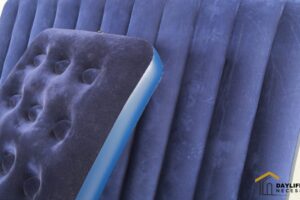Hey there, fellow DIY enthusiast! So, you’ve decided to upgrade your bathroom with a sleek and functional double sink vanity. That’s a fantastic choice!
Double sink vanities not only add style to your bathroom but also provide practicality, especially during those busy mornings when everyone’s trying to get ready at once.
But before you can enjoy the convenience of a double sink vanity, you need to know how to rough in the plumbing correctly.
In this guide, I’ll walk you through each step, ensuring your double sink vanity installation is a breeze.
Gather Your Tools and Materials
Before you dive into the rough-in process, make sure you have all the necessary tools and materials ready.
You’ll need a measuring tape, pipe wrench, tubing cutter, PVC primer and cement, connectors, water supply lines, drain pipes, and, of course, the double sink vanity itself.
Ensure you select pipes and fittings that are suitable for bathroom use and durable enough to last for years to come.
Measure and Mark
Now that you have everything at hand let’s start with measuring and marking the sink and drain locations.
Precise measurements are crucial to ensure that the double sink vanity fits perfectly into your bathroom space.
Mark the positions of the sinks and drains on the wall and floor carefully, taking into account the necessary clearances.
Keep in mind that a well-measured and marked installation will save you a lot of headaches later on.
Shut Off Water and Remove Old Fixtures (if applicable)
Safety first! Before you begin any plumbing work, shut off the water supply to the bathroom.
Once that’s done, remove any old fixtures if you’re replacing an existing vanity. Removing the old fixtures will provide you with a clean slate to work on and make the rough-in process much more manageable.
Install Drain and Water Lines
Now comes the core of the rough-in process – installing the drain and water lines for the double sink vanity.
It’s essential to use the correct pipe sizes and connectors to ensure smooth water flow and prevent leaks.
Securely connect the pipes to the sinks and the main water supply, and you’re on your way to a fully functional double sink vanity.
Ventilation Considerations
Ah, the ever-important ventilation! Proper ventilation for the sink drains is vital to avoid any unwanted odors in your bathroom.
Install a ventilation system that connects to the drainpipes, leading the odors safely outside. Trust me; your nose will thank you for it!
Test for Leaks
You’ve installed the plumbing, but the work’s not over yet. Before moving on, conduct a thorough leak test to ensure everything is watertight.
Check each connection for leaks, and if you find any, fix them promptly. A little extra time spent on testing can save you from major headaches in the future.
Secure the Vanity in Place
The plumbing is in place, but we’re not done just yet. Securely anchor the double sink vanity in its designated location.
Use shims if needed to ensure stability and proper alignment with the plumbing. A wobbly vanity won’t do justice to your hard work!
Connect the Faucets and Drains
The finish line is in sight! Connect the faucets and drains to the water and drain lines.
Apply plumbers’ putty or use silicone seals for a watertight connection. Remember, you want those sinks to work flawlessly and look fantastic at the same time!
Double Sink Vanity Drainage Options
Before you wrap things up, let’s talk drainage options. You have a few choices when it comes to draining water from your double sink vanity.
You can have both sinks drain into a single pipe, each sink having its pipe, or using a sink with a center drain.
Choose the option that best fits your bathroom layout and personal preferences.
Additional Considerations for DIYers
As an avid DIYer, I know you’re excited to tackle this project, but remember to put safety first.
Always wear appropriate safety gear, follow the manufacturer’s instructions, and avoid rushing the process.
Take your time and ensure you’re doing everything correctly. And if you ever feel overwhelmed or encounter unexpected issues, don’t hesitate to ask for help.
Seek Professional Help When Needed
While I have faith in your DIY skills, some plumbing tasks might be better left to the professionals.
If you’re unsure about any aspect of the rough-in process or encounter complex plumbing issues, it’s best to call in a plumber. It’s better to be safe than sorry!
Double Sink Vanity Design Ideas
Now that we have the plumbing sorted out let’s talk aesthetics. Double sink vanities come in various designs, and you can pick one that suits your bathroom’s style and layout.
Whether you prefer a modern, minimalist look or a classic, elegant design, there’s a double sink vanity out there that’s perfect for you.
Maintaining Your Double Sink Vanity
Congratulations! You’ve successfully roughed in your double sink vanity. Now, to keep it in top-notch condition, regular maintenance is essential.
Avoid putting anything down the drains that could cause clogs and address minor plumbing issues as soon as they arise.
A little maintenance goes a long way in extending the life of your vanity.
Conclusion
Roughing in a double sink vanity may seem like a daunting task, but with the right tools, knowledge, and patience, it’s a project well within your capabilities.
By following this guide, you’ve taken the first steps towards a beautiful and functional bathroom upgrade that will serve you and your family for years to come.
So, roll up your sleeves, get ready for some plumbing adventure, and revel in the satisfaction of a job well done!
FAQs: How to Rough In a Double Sink Vanity
Q1: Can I rough in a double sink vanity by myself?
A1: Absolutely! With the right tools and instructions, roughing in a double sink vanity is a manageable DIY project.
Q2: How long does it take to rough in a double sink vanity?
A2: The time required depends on your experience and the complexity of your bathroom’s plumbing. It can take a few hours to a full day.
Q3: Do I need special skills to rough in a double sink vanity?
A3: While it’s beneficial to have some basic plumbing knowledge, this guide is designed to help beginners navigate the process.
Q4: Can I use flexible pipes for the rough-in?
A4: While flexible pipes might seem convenient, it’s best to use rigid pipes for the main plumbing connections to ensure stability and durability.
Q5: Do I need to get a building permit for this project?
A5: In some areas, you might require a building permit for plumbing work. Check with your local authorities to ensure you’re complying with regulations.




